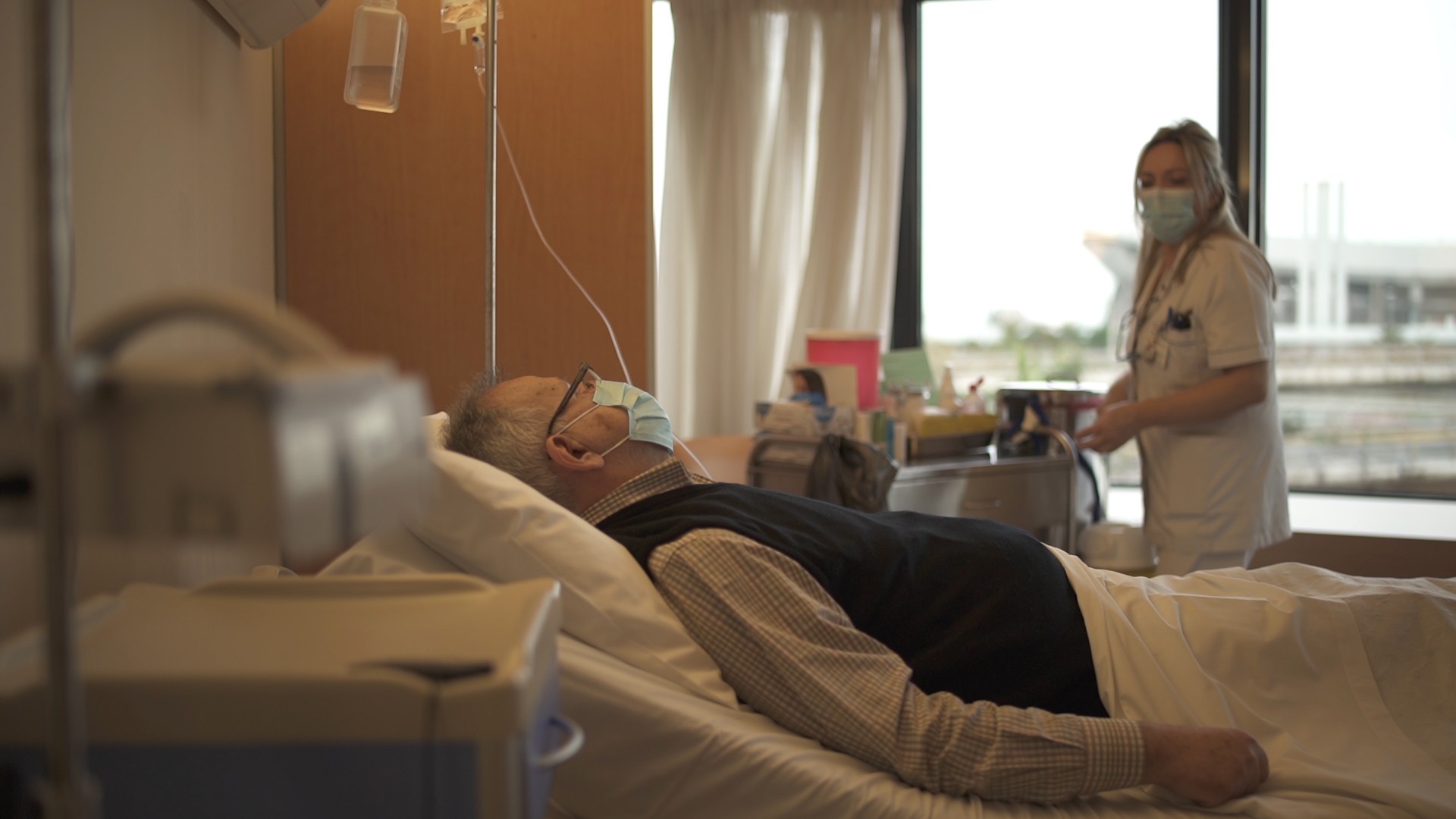Ontario Premier Doug Ford hinted that more lockdown measures are likelyCole Burston/Bloomberg via Getty Images
Ontario’s lagging and inconsistent vaccine rollout is creating frustration and confusion as people gear up to lock down yet again to overcome the province’s deadly third wave.More confusion arose over the weekend when a local official’s tweet advertised a “standby list” for people, including young adults, to sign up on a “first come, first served” basis for last-minute vaccinations as a way to use up leftover doses at the end of each day.Over the weekend Rob Fernicola got word that a nearby vaccine clinic in east Toronto was offering a standby list, so he signed up and easily secured an appointment for Wednesday. He said there were several time slots available all week. But Fernicola, a 46-year-old man with no underlying health conditions, said he wasn’t sure if the standby list was legitimate, since he isn’t yet eligible to get a vaccine. At one point, he even thought he may have fallen for a phishing scam. (Ontario is still in Phase 1 of its rollout, which includes priority for health care workers and people over 70.) Fernicola made a few calls to COVID-19 main lines and eventually learned from the hospital his appointment was set. But an alleged error in the booking system opened vaccine appointments to all, even those who aren’t eligible, Fernicola said.“I cancelled my appointment,” Fernicola said. “They politely asked (by email) to cancel the appointment if you don't meet current requirements of being over 75.”Ontario has about 650,000 vaccines sitting idle as of Wednesday—although shipments of new vaccine outpacing administration isn’t necessarily a bad thing—and that many are wasted at the end of the day. As of Wednesday, the province had administered about 77 percent of its vaccine supply, with more doses of Pfizer and Moderna vaccines on the way. Officials in Ontario are concerned about the many unfulfilled vaccine appointments, even while COVID-19 cases are rapidly increasing. Toronto Mayor John Tory even pleaded with people 70 and older to sign up. “We have the vaccines, we have the staff in place to do it and we have the appointments, so all we need now is you,” Tory said. “It’s very, very important for people across the city of Toronto to get vaccinated.”Tory also asked the province if Toronto can start vaccinating people over 60.“With something like a standby list or waiting list when people don’t show up and (clinics) have unused capacity—I just don't understand why the province wouldn't give clinics some discretion in that regard,” Fernicola said. “If there is capacity, I don't see the downside to that.”Setting up standby or waiting lists could work—as long as equity is always factored in and the process is “synchronized and streamlined” across Ontario, according to Dr. Naheed Dosani, an Ontario-based palliative care physician and health equity advocate. “After prioritizing equity, if we still have leftover supply, it is important to ensure we don't waste that supply,” he said.A drawback, though, is they favour people who are well-off, have easy access to transportation, and can take time off work on a whim. “These are important considerations for any system that is established when considering a standby approach,” Dosani said.According to Dosani, one of the vaccine rollouts' biggest hurdles is its inconsistency across regions and neighbourhoods. The result is that people like Fernicola have to assess for themselves whether it’s ethical for them to sign up for a jab—instead of relying on the government to coordinate vaccinations simply, effectively, and equitably.It “shouldn’t be that way,” considering the province has laid out equity guidelines in its phased vaccination plan, Dosani said.“I’ve had many people saying, ‘I’ve got a spot, but I'm young and healthy and feel guilty,’ and even though they could have gotten the vaccine, they declined their appointment,” Dosani said. “Why is the rollout so inconsistent and creating these situations in the first place?” Pharmacies, for example, most of which are in richer neighbourhoods, have been used to administer jabs, but family doctors and primary health care workers have not—and there were no pharmacies offering vaccine in five of Toronto’s hardest hit communities. “To me that’s just illogical,” Dosani said. “Doctors were not involved in the rollout to begin with, so people who have built trusted relationships with health providers are not connecting with them around COVID-19 vaccine.” That means, it’s also harder for doctors to support people who are hesitant to get the shot.Dosani said the province needs to do more to deliver vaccines to the hardest hit communities, and to address vaccine hesitancy among people, many racialized or low-income, who have been repeatedly mistreated by health care systems. There are other equity-focused solutions, too. Dosani said the province needs to direct vaccine doses to COVID-19 hotspots; consider mobile vaccine campaigns to get doses out to people who are less mobile, homebound, or in hard-hit communities; and deliver robust, compassionate public relations campaigns that educate people about the vaccine. “It behooves us to create innovative solutions,” Dosani said. Ontario is expected to announce yet another lockdown on Thursday as the third wave threatens to overwhelm the province and makes young and middle-aged adults sicker than ever. There are currently 19,810 active COVID-19 cases across Ontario, with Ontario reporting more than 2,000 new cases seven days in a row. Hospitalizations are also breaking records. Currently 421 people are suffering from COVID-19 in intensive care across Ontario hospitals—the highest number at any given time yet.COVID-19 variants are fuelling the scary rise in infections and make up about 67 percent of all cases. The B.1.17 variant, first detected in the U.K., can result in more severe illness and is up to 50 percent more transmissible.The variants’ spread is outpacing the province’s vaccine rollout, which is already being scrutinized for being too confusing, ethically dubious, and slow.The only way to temper the spread of COVID-19 is to impose restrictions, Health Canada modelling shows. Vaccines “are coming but we still need time for rollout; this situation won’t get better unless we follow public health guidance,” Canada’s top doctor Theresa Tam said on Tuesday. Prime Minister Justin Trudeau said Canada is still on track to vaccinate all adults who want to be vaccinated by summer’s end.Follow Anya Zoledziowski on Twitter.
But Fernicola, a 46-year-old man with no underlying health conditions, said he wasn’t sure if the standby list was legitimate, since he isn’t yet eligible to get a vaccine. At one point, he even thought he may have fallen for a phishing scam. (Ontario is still in Phase 1 of its rollout, which includes priority for health care workers and people over 70.) Fernicola made a few calls to COVID-19 main lines and eventually learned from the hospital his appointment was set. But an alleged error in the booking system opened vaccine appointments to all, even those who aren’t eligible, Fernicola said.“I cancelled my appointment,” Fernicola said. “They politely asked (by email) to cancel the appointment if you don't meet current requirements of being over 75.”Ontario has about 650,000 vaccines sitting idle as of Wednesday—although shipments of new vaccine outpacing administration isn’t necessarily a bad thing—and that many are wasted at the end of the day. As of Wednesday, the province had administered about 77 percent of its vaccine supply, with more doses of Pfizer and Moderna vaccines on the way. Officials in Ontario are concerned about the many unfulfilled vaccine appointments, even while COVID-19 cases are rapidly increasing. Toronto Mayor John Tory even pleaded with people 70 and older to sign up. “We have the vaccines, we have the staff in place to do it and we have the appointments, so all we need now is you,” Tory said. “It’s very, very important for people across the city of Toronto to get vaccinated.”Tory also asked the province if Toronto can start vaccinating people over 60.“With something like a standby list or waiting list when people don’t show up and (clinics) have unused capacity—I just don't understand why the province wouldn't give clinics some discretion in that regard,” Fernicola said. “If there is capacity, I don't see the downside to that.”Setting up standby or waiting lists could work—as long as equity is always factored in and the process is “synchronized and streamlined” across Ontario, according to Dr. Naheed Dosani, an Ontario-based palliative care physician and health equity advocate. “After prioritizing equity, if we still have leftover supply, it is important to ensure we don't waste that supply,” he said.A drawback, though, is they favour people who are well-off, have easy access to transportation, and can take time off work on a whim. “These are important considerations for any system that is established when considering a standby approach,” Dosani said.According to Dosani, one of the vaccine rollouts' biggest hurdles is its inconsistency across regions and neighbourhoods. The result is that people like Fernicola have to assess for themselves whether it’s ethical for them to sign up for a jab—instead of relying on the government to coordinate vaccinations simply, effectively, and equitably.It “shouldn’t be that way,” considering the province has laid out equity guidelines in its phased vaccination plan, Dosani said.“I’ve had many people saying, ‘I’ve got a spot, but I'm young and healthy and feel guilty,’ and even though they could have gotten the vaccine, they declined their appointment,” Dosani said. “Why is the rollout so inconsistent and creating these situations in the first place?” Pharmacies, for example, most of which are in richer neighbourhoods, have been used to administer jabs, but family doctors and primary health care workers have not—and there were no pharmacies offering vaccine in five of Toronto’s hardest hit communities. “To me that’s just illogical,” Dosani said. “Doctors were not involved in the rollout to begin with, so people who have built trusted relationships with health providers are not connecting with them around COVID-19 vaccine.” That means, it’s also harder for doctors to support people who are hesitant to get the shot.Dosani said the province needs to do more to deliver vaccines to the hardest hit communities, and to address vaccine hesitancy among people, many racialized or low-income, who have been repeatedly mistreated by health care systems. There are other equity-focused solutions, too. Dosani said the province needs to direct vaccine doses to COVID-19 hotspots; consider mobile vaccine campaigns to get doses out to people who are less mobile, homebound, or in hard-hit communities; and deliver robust, compassionate public relations campaigns that educate people about the vaccine. “It behooves us to create innovative solutions,” Dosani said. Ontario is expected to announce yet another lockdown on Thursday as the third wave threatens to overwhelm the province and makes young and middle-aged adults sicker than ever. There are currently 19,810 active COVID-19 cases across Ontario, with Ontario reporting more than 2,000 new cases seven days in a row. Hospitalizations are also breaking records. Currently 421 people are suffering from COVID-19 in intensive care across Ontario hospitals—the highest number at any given time yet.COVID-19 variants are fuelling the scary rise in infections and make up about 67 percent of all cases. The B.1.17 variant, first detected in the U.K., can result in more severe illness and is up to 50 percent more transmissible.The variants’ spread is outpacing the province’s vaccine rollout, which is already being scrutinized for being too confusing, ethically dubious, and slow.The only way to temper the spread of COVID-19 is to impose restrictions, Health Canada modelling shows. Vaccines “are coming but we still need time for rollout; this situation won’t get better unless we follow public health guidance,” Canada’s top doctor Theresa Tam said on Tuesday. Prime Minister Justin Trudeau said Canada is still on track to vaccinate all adults who want to be vaccinated by summer’s end.Follow Anya Zoledziowski on Twitter.
Advertisement

Advertisement
Advertisement
Advertisement
